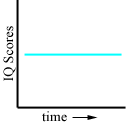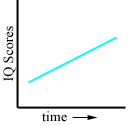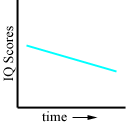Originally prepared by: Charles Graham (fall 2001)
Revised: Jonathan Plucker (fall 2002)
The Flynn Effect deals with the issue of how the general IQ scores of a population change over time. Below are three graphs indicating possible trends and fluctuations of IQ scores over time. Click on the image which most accurately portrays how you think IQ scores have changed with time?




 Introduction
Introduction  How large are the IQ gains?
How large are the IQ gains?  Where is the IQ test data from?
Where is the IQ test data from?  What are possible causes for the Flynn Effect?
What are possible causes for the Flynn Effect?  Why must IQ tests be constantly restandardized?
Why must IQ tests be constantly restandardized?  Who has written about the Flynn Effect?
Who has written about the Flynn Effect?
Fluid Intelligence
Tests like the Ravens, the Norwegian matrices, the Belgian Shapes test, the Jenkins test, and the Horn test are examples of tests that attempt to measure fluid intelligence. These tests try to emphasize problem solving and minimize a reliance on specific skills or familiarity with words and symbols. These tests on average have shown an increase of about 15 points or one standard deviation per generation (Flynn, 1994)(Flynn, 1987). Deary (2001) notes that it is these types of tests (i.e., “culturally reduced”) on which we would not expect to see score increases if the cause of the increases was due to educational factors.
Crystallized Intelligence
Tests like the Wechsler-Binet and purely verbal tests measure crystallized intelligence in addition to fluid intelligence. Some questions on these tests measure problem solving abilities but others measure learned information such as vocabulary and math skills. The IQ gains for these tests have been more moderate, with an average of about 9 points per generation (Flynn, 1994)(Flynn, 1987).
The countries from which data has been gathered to research the increase of IQ scores over time are: Australia, Austria, Belgium, Brazil, Britain, Canada, China, Denmark, East Germany, France, Israel, Japan, Netherlands, New Zealand, Northern Ireland, Norway, Sweden, Switzerland, United States of America, and West Germany (Flynn, 1994).
Flynn’s Hypothesis
“The hypothesis that best fits the results is that IQ tests do not measure intelligence but rather correlate with a weak causal link to intelligence.” (Flynn, 1987). Based on the presence of the effect on nonverbal tests such as the Raven’s Matrices, Flynn believes that the increase is actually an increase in abstract problem solving rather than intelligence. Flynn (1994, 1999) favors environmental explanations for the increase in test scores.
Education a cause of IQ gains?
In many countries the level of education of the general public is increasing. People are spending a larger amount of their time learning and being examined in formal educational settings. In some cases IQ gains are highly correlated to increased years spent in formal education. Again, several scholars point at the increase in culture-free tests as evidence against an educational cause.
The Brand hypothesis: Societal changes causing IQ gains?
Brand suggested that societal changes that teach testing with “time limits” could be a cause of IQ gains. The idea behind this hypothesis is that people in our society have learned to work better within a limited time frame. This societal trend allows later generations to score better on timed tests because they make intelligent guesses and don’t waste time trying to get every test item correct. Although this hypothesis seemed promising, there has been research that contradicts its fundamental assumptions (Flynn, 1994)
Better nutrition a cause of IQ gains?
It has also been hypothesized that IQ gains are the results of better world wide nutrition. The idea behind this hypothesis is that better nourished brains would allow subjects to perform better on IQ tests as well as in everyday activities. Experimental data trying to prove this theory are also mixed leading one to believe that nutrition, though a possible contributing cause, cannot account entirely for the massive gains in IQ measured around the world (Flynn, 1994).
Because populations experience IQ gains over time, IQ tests must be constantly restandardized so that subjects are not scored against inaccurate norms. Using obsolete IQ norms can cause problems especially when comparing scores between different groups and populations. Flynn documents an example where scores from a group of Chinese Americans were being compared to an earlier generation of white Americans. This simple mistake caused the researchers to believe that they were working with “an elite IQ group” when in actuality they were working with a group of high achievers with comparable IQs to their peers (Flynn, 1991). In another case documented by Flynn, IQ scores were compared against obsolete norms to incorrectly show large increases in IQ between children adopted into “good” homes and their biological mothers (Flynn, 1984).
A widely held hypothesis is that people lose fluid intelligence as they age. This phenomena is caused by comparing the IQ tests of elderly people with today’s young people. However, when compared to the IQ scores of youth in their own era (a half a century before) the IQ losses with age are minimal (Raven, 1992, pp. G22-G26). In a final example, Flynn explains that the WISC, an intelligence test used widely in the United States, was not restandardized for 25 years between 1947 and 1972. This comparison of IQ scores to obsolete norms caused the number of children who were officially classified as mentally retarded to drop from 8.8 million in 1947 to 2.6 million in 1972 (Flynn, 1985).
A note of caution: The Flynn Effect illustrates the difficulty of comparing test results over time, but it says little about the validity of the tests within a given time period (Flynn talks about the validity “within generations”).
Deary, I. J. (2001). Intelligence: A very short introduction. Oxford: Oxford University Press.
An accessible and colorful analysis of a wide range of intelligence topics. The chapter on the Flynn Effect (Chapter 6) is among the best in the book.
Flynn, J. R. (1984). The mean IQ of Americans: Massive gains 1932 to 1978. Psychological Bulletin, 95, 29-51.
Flynn, J. R. (1985). Wechsler intelligence tests: Do we really have a criterion of mental retardation? American Journal of Mental Deficiency, 90, 236-244.
Flynn, J. R. (1987). Massive IQ gains in 14 nations: What IQ tests really measure. Psychological Bulletin, 101,171-191.
Flynn, J. R. (1991). Asian Americans: Achievement beyond IQ. Hillsdale, NJ: Erlbaum.
Flynn, J. R. (1994). IQ gains over time. In R. J. Sternberg (Ed.), Encyclopedia of human intelligence (pp. 617-623). New York: Macmillan.
Flynn, J. R. (1999). Searching for justice: The discovery of IQ gains over time. American Psychologist, 54, 5-20.
Of Flynn’s numerous publications on his intelligence work, the 1994 and 1999 papers provide good summaries of his positions on the Flynn Effect. The 1999 article contains greater elaboration on his opinions regarding social justice than is found in the other publications. Readers interested in Flynn’s methodology should consult the 1984 and 1987 articles.
Jensen, A. R. (1989). Rising IQ without increasing g? [A review of The Milwaukee Project: Preventing mental retardation in children at risk]. Development Review, 9, 234-258.
Lynn, R. (1987). Japan: Land of the rising IQ, A reply to Flynn. Bulletin of the British Psychological Society, 40, 464-468.
Neisser, U. (Ed.). (1998). The rising curve. Washington, DC: American Psychological Association.
This edited volume is highly recommended. It is especially useful for readers interested in the wide range of possible explanations for the Flynn Effect.
Raven, J. C., Court, J. H., & Raven, J. (1992). Manual for Raven’s progressive matrices and vocabulary scales (section 3). Oxford: Oxford Psychologist Press.
Originally prepared by Charles Graham with subsequent revisions by Jonathan Plucker. Please feel free to contact us with issues, questions, and contributions that you feel would help others using this site as a resource.
